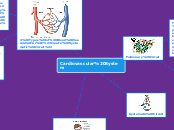realizată de Lindsey robinson 6 ani în urmă
706
Cardiovascular
Blood circulation involves the systemic and pulmonary circuits, each playing distinct roles. The systemic circuit transports oxygenated blood from the left ventricle throughout the body, delivering oxygen and nutrients to tissues via capillaries.









